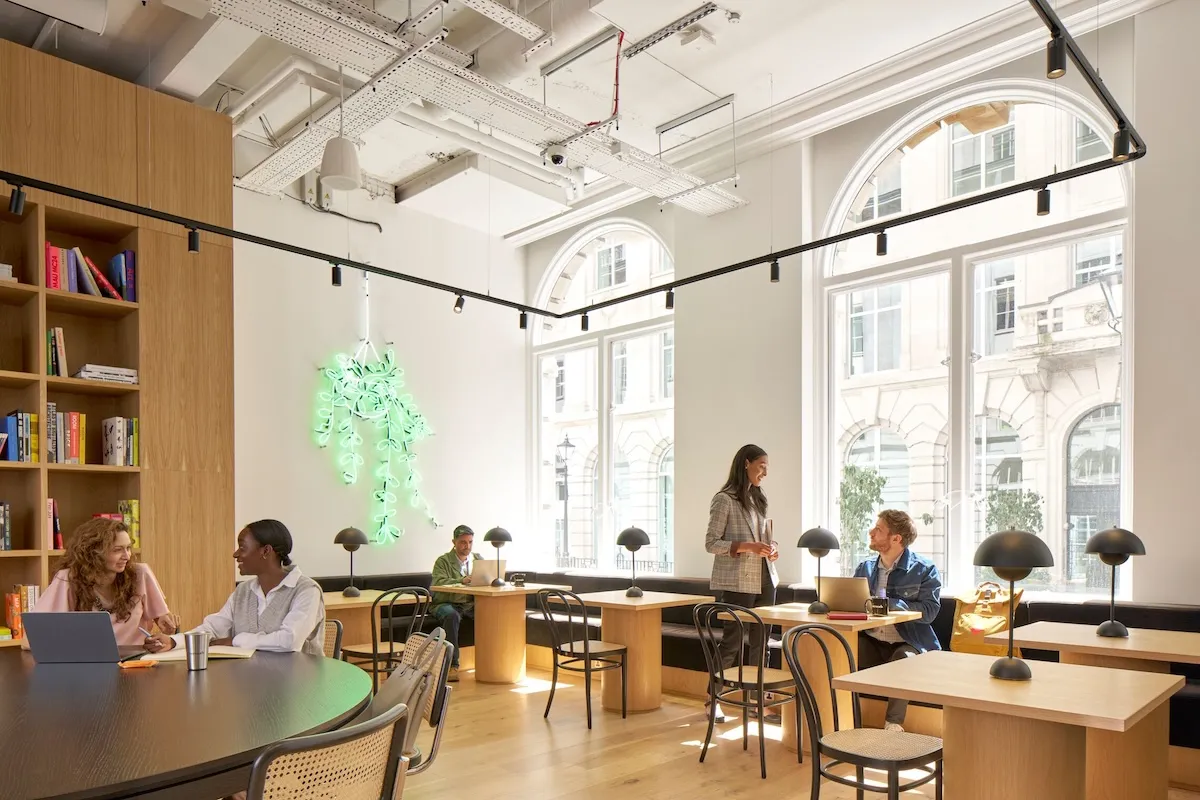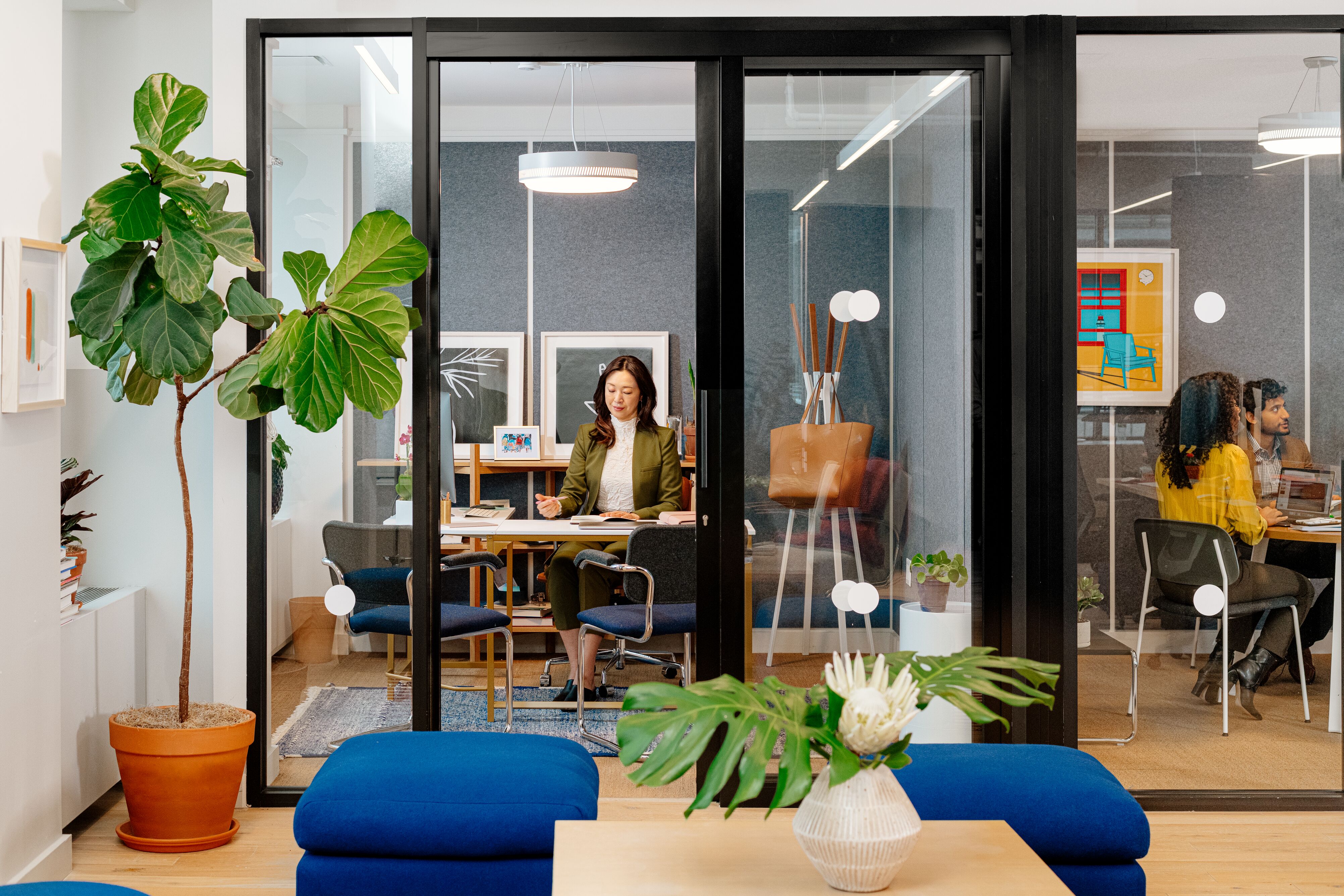As the end of the COVID-19 pandemic gleams temptingly in the not-too-distant future, both workers and companies alike are considering what a return to the office will look like. Can the office still be an all-important central hub, now that so many knowledge workers have proven they can work efficiently and effectively from home? When will we all feel comfortable working eight or more hours a day an arm’s length from the next workstation?
WeWork recently gathered together three leaders in workplace culture and planning to discuss these issues and more. Moderator Darin Vest, head of the enterprise real estate center of excellence at WeWork, was joined by Bill Hansen, global head of real estate and workplace services at Flexport; Tamara Mahru, who leads the global real estate and workplace function at Twilio; and Darin Buelow, a principal from Deloitte Consulting, who’s a leader in its real estate and location strategy practice. Watch the webinar on-demand.
The panel discussed ways to bring employees back to the office, as well as the office’s evolving purpose and long-term management strategy. Here are some highlights from the discussion.
WeWork: The big question out of the gate is, what is the role of the office?
Mahru: There will [still] be conference rooms, desks, lounges. The difference is in how often people utilize these particular spaces and whether the ratios that we were previously attaching to them pre-COVID remain post-COVID.
Rather than the central place where people get work done, [the office] becomes one of many options. And it essentially becomes a tool in the working toolbox for any employee as an option that they can choose to meet the needs they have on any particular day.
Although we’re productive at the moment, as we try to sustain this long term, are we going to start to see a drop-off in productivity?
Buelow: A major Bay Area technical and technology company looked at how their engineers worked pre-COVID. They spent a lot of time in the office, heads down, coding sometimes 18 hours a day, and got about five hours of solid coding done per day. The company has been studying these same engineers during COVID, all working at home.
In COVID times, they’re still getting five hours of solid coding time out of the engineers, but it’s happening right away in the morning when they start working, and then they pretty much are done being productive around one or two in the afternoon. So that company is not seeing a productivity drop-off in their coding engineers.

Hansen: It’ll be interesting to see how we measure productivity, if that evolves. Maybe you’re getting five hours of coding either way. But is the code better when they’re in the office talking to people who are more senior and bouncing ideas off one another, because you have that super senior engineer sitting next to you?
It’s one thing to measure somebody’s time spent at their desk—it’s another thing to measure how good it is.
How does a sense of strong company culture survive in this hybrid model?
Buelow: Many leadership teams have not been trained on how to manage a distributed workforce, on what tricks and strategies they should be employing to preserve and build culture within a distributed workforce. At Deloitte, we’ve been a remote and virtual organization for decades. So for us, this wasn’t a big pivot.
But we’ve learned over time that to preserve culture, we have to break these big businesses into small familial units, with leaders who know the names of the people on their team. They know the names of the kids of those people on their team. They know where people live and what their hopes and dreams are and what their challenges are and what they need to to thrive and survive in the organization. You get too big, you lose that.
That’s just one example, but I think this is a huge topic. And it’s going to drive this tension between forcing people to come back to offices versus giving them choice.
One’s current real estate portfolio might be misaligned with the utilization pattern of today and what it’s going to be in the near future. How do real estate departments deal with that misalignment?
Hansen: I think the change will be gradual. So, for example, if you plan to increase headcount, you may not need to take on more real estate in order to accommodate that count, because as the years go on, you don’t have as many people in on a daily basis.
That’s an exciting way to flex that muscle. You can also decrease the size of the physical office, and I think that would benefit culture, you know, actually that’s going to have a positive impact. I’ve been at big headquarters where you walk around and don’t know anybody—it’s kind of a lonely feeling.
Then you walk into those smaller offices that have like 150 or fewer, and everyone knows one another. They’re friends, they hang out. The culture is stronger versus in a larger office, where they get the same benefits—they get lunch and have happy hours—but they feel better in those smaller communities. I think leveraging real estate to help facilitate that is really going to be an important part of the future.
How do you wade through this environment with so much uncertainty, and how do you make a decision?
Hansen: Certainly right now flexibility is the key thing. I look at flexibility and cost, because every time you move there’s just more and more cost. Moving isn’t free.
I also think employees will be happier in the long run if we kind of tiptoe into this. Because the worst thing we can do is tell someone, “You only have to come in once a week,” then they move 100 miles away from the office—and then we figure out “Wait, you’re not productive, we need you in five days a week.”
Now they’re going to be upset with you. So I think there are so many reasons that we will benefit from a gradual change versus just to kind of push into the deep end of a cold pool.
What are the biggest changes you guys are making today in the office space itself?
Hansen: More meeting space. You also need to provide more quiet space, more phone booths. Less dedicated seats and more hot desks. Those are the kind of changes that we’re making in the workplace.
Buelow: We are seeing greater interest in the hub-and-spoke model, different location models. Trying to open up additional centers in the suburbs, maybe to enable employees to drop in when they want to, in a smaller location, without having to make an hour-and-a-half commute.

The backdrop of all of that, of course, is the awareness that once things start to sort themselves out, companies may likely shrink how many square feet of office they have.
Are you able right now to leverage data for decisions? Do you have enough information?
Buelow: We’re doing that work now with companies, using surveys that are very thoughtful in terms of asking people how they will work in the future, how they want to work in the future, and combining them with talent analytics that look at every job and how much collaboration and face-to-face time and in-office time is required to do that job. And then combining that with leadership interviews to talk person by person.
That data is out there, and you can look at pre-COVID data, combine that with the things that I’m talking about, and come up with some hypotheses about what the future footprint might need to look like.
How does technology play into this?
Buelow: There are a lot of technologies out there that can ease some of these transitions, from space management to occupancy sensing to collaboration tools. We have to think about a future where we have to make it easier for people who are in the office to collaborate with those people who are working somewhere else. And I don’t think a lot of companies have that figured out.
How do you whiteboard effectively with people in the room and people dialed into a video con? There is opportunity there for us to improve the work experience through technology.
Any advice for others about how to approach this, and what’s worked for you at your company?
Mahru: Be open to experimentation, and don’t bank on trying to go back to the way it was. Really think differently—but try not to make really, really huge decisions that you don’t know how they’re going to play out once people are back in the office.
It took a long time to get to the office that we knew of before COVID, and it’s going to take some time for us to reimagine what the new office is going to look like post-COVID.
Rethinking your workspace?










